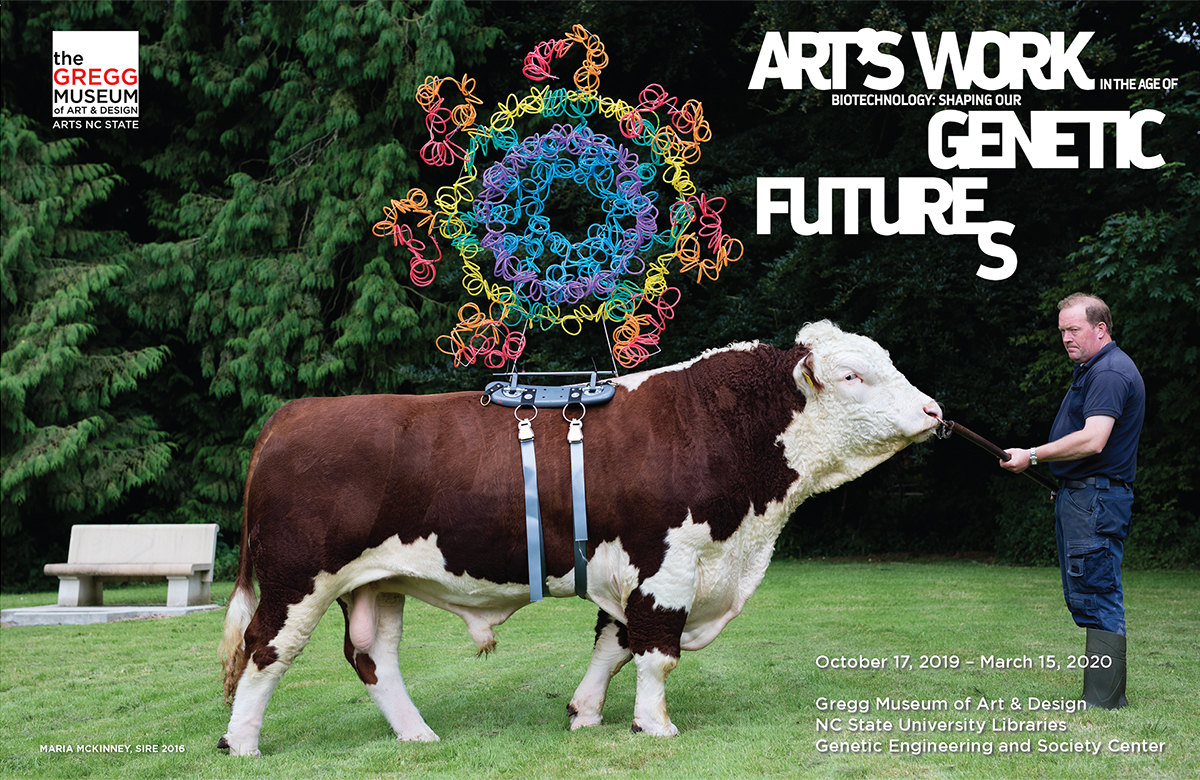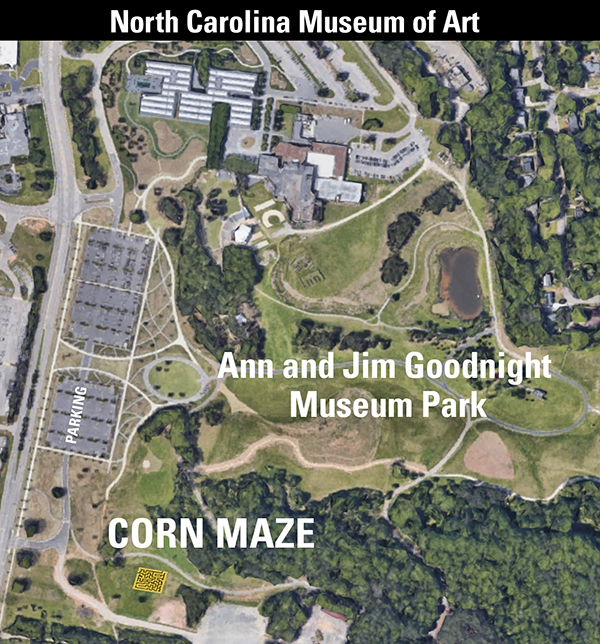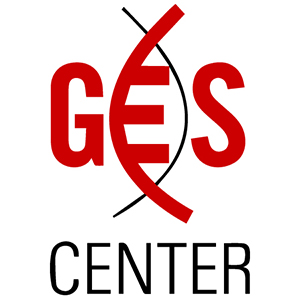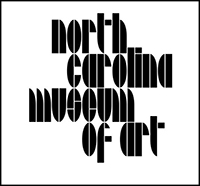ARTWORKS | SYMPOSIUM | NEWS | CORN MAZE | ABOUT | PROJECT TEAM | FIELD TRIAL | PARTNERS
View and read about all of the artworks and artists from the 2019-2020 NC State exhibition.
ART’S WORK 2.0: University of PittsburghThe next iteration of Art’s Work/Genetic Futures, the new exhibition expands on conversations that began here at NC State, featuring an entirely different slate of artworks.
EXHIBITION CATALOG
A full-color, 144-page, printed catalog of the exhibition is available through UNC Press. The catalog is also viewable as a PDF online here.
SYMPOSIUM
Symposium – Art’s Work/Genetic Futures Exhibition, Oct 18, 2019 at Gregg Museum, NC State from GES Center, NC State on Vimeo.
To jump to a specific speaker’s response, there are two options:
- Video chapters: Each speaker’s response is marked directly on the video timeline above, or
- Timestamp (00:00): Opens a new window on Vimeo at that speaker’s response
Clicking on the linked titles will take you to that artwork’s image, description and artist bio on the Artworks page.
Speaker Responses to Art’s Work/Genetic Futures:
Download the symposium program
- (00:45) Welcome from Fred Gould
- (04:58) Molly Renda and Jim Holland on From Teosinte to Tomorrow (begin audio re-dub)
- (08:48) Jennifer Kuzma on In Posse: the making of female sperm by Charlotte Jarvis
- (13:21) Darrell Stover on Terra et Venti by Joel Ong (end audio re-dub)
- (18:25) Carole Saravitz on Errorareum by Adam Zaretsky
- (24:24) Jen Baltzegar on Chemical Bouquet II and Miracle Grow by Kirsten Stolle
- (31:17) Helen Burgess on America Project by Paul Vanouse
- (41:03) Mark Olsen on Lucky Mice by Joe Davis and Dana Dal Bo
- (51:30) Nora Haenn on Fragments by Emeka Ikebude
- (57:46) Amy Sheck on Baroque Biology by Jennifer Willet
- (1:06:22) Elizabeth Pitts on The Mermaid De-extinction Project by Rich Pell
- (1:13:42) Todd Kuiken on the 2018 MICA BioDesign Challenge Team’s Kerasynth
- (1:21:57) Chris Tonelli on Novel Ecosystem Generator by Aaron Ellison and David Buckley-Borden
- (1:28:24) Christian Maltecca on Sire by Maria McKinney
- (1:36:05) Fred Gould on We Make Our Own Luck Here by Ciara Redmond
- (1:49:23) Audience comments, including Jen Baltzegar on Stranger Visions by Heather Dewey-Hagborg
The Genetic Engineering and Society (GES) Center, NC State University Libraries, and Gregg Museum of Art & Design hosted a full-day symposium to discuss the Art’s Work/Genetic Futures exhibition. The symposium brought together artists, humanists, and social/natural scientists, using the exhibition as a departure point for conversations about the future of biotechnology and genetics.
The exhibition provokes questions about who has the standing to comment on or even create our genetic futures. It shows how artists and designers can contribute materially, rhetorically, and conceptually to biotechnology’s development. The selected works question the all-too-common assumption that scientists and engineers hold the power to create new futures that will come to pass without the input of other people. By highlighting artists’ contributions in these areas and bringing the public into the conversation as a partner rather than a recipient of technical knowledge, visitors will be encouraged to consider the contributions artists and scientists are making toward shaping our genetic futures, the effects these innovations and ideas will have on their own lives, and their own roles in this process.
The symposium places art at the center of discussions about the future of biotechnology by presenting works in which artists appropriate tools and techniques of modern biotechnology that have until recently been the exclusive purview of scientists. The event used the exhibition as a departure point for conversations about the future of biotechnology and genetics. The morning session was held at the Gregg Museum of Art & Design and continued at the NC State’s D.H. Hill Jr. Library Auditorium in the afternoon. The morning session consisted of responses from scientists, humanities scholars, artists, and members of the public to specific artworks in the show.
In the afternoon, three panels of artists convened at D.H. Hill Jr. Library Auditorium to discuss:
2—3 pm: Biotechnology as Culture
Moderator: Priscilla Wald
Panelists: Joe Davis, Jennifer Willet, Ciara Redmond, Kirsten Stolle, Maria McKinney, and Rich Pell
3—4 pm: Genetic Arts Intervening in the Anthropocene: Climate, Geoengineering, and Ecosystems
Moderator: Jason Delborne (Science, Policy and Society)
Panelists: Aaron Ellison, David Buckley Borden, Jon Davis, Joel Ong, Erin Kirchner, and Rachel Rusk
4—5 pm: Art and Identities: From Surveillance and Privacy to Collective Identities and Personal Choices
Moderator: Patsy Sibley (Women’s Studies)
Panelists: Charlotte Jarvis, Paul Vanouse, Adam Zaretsky, and Emeka Ikebude
The symposium concluded with an open conversation on how we develop richer interfaces between artists and scientists in determining our genetic futures.
NEWS
Blog: Review of Art’s Work in the Age of Biotechnology: Shaping Our Genetic Futures | We Make Money Not Art
Regine Debatty - April 6, 2020 | Artists offer new insights about genetic engineering by bringing it out of the lab and into public places to challenge viewers’ understandings about the human condition, the material of our bodies
Indy Week: At the Crossroads of Art and Biotech, a Warning: Be Careful What You Wish For
Brian Howe - January 13, 2020 | The Gregg Museum's "Art's Work in the Age of Biotechnology: Shaping Our Genetic Futures" is less concerned with answering big questions than in finding head-spinning new ways to ask them.
WUNC: An Ancient Greek Festival For Creating Female Sperm
Grant Holub-Moorman & Anita Rao - January 10, 2020 | Semen is a potent substance, both literally and symbolically. It was described by Chinese proverb as “equal to ten drops of blood”; by Sumerians as “a divine substance...
Art the Science Blog: WORKS – Art’s Work in the Age of Biotechnology
Alice Fleerackers - January 7, 2020 | From "designer babies" to de-extinct woolly mammoths, recent developments in biotechnology have profoundly changed what we view as possible. But each of these possibilities brings...
Margaret Atwood and the Biotechnology of Tomorrow
Renowned author Margaret Atwood visited NC State to discuss fiction's role in the future of biotechnology and genetic engineering.
Announcing: Art’s Work in the Age of Biotechnology: Shaping Our Genetic Futures Exhibition
Raleigh, NC – NC State University Libraries and the Genetic Engineering and Society (GES) Center present the Art’s Work in the Age of Biotechnology, opening at the Gregg Museum of Art & Design on Thursday, October 17, 6 to 8 p.m.
NC State corn maze opens at NC Museum of Art through October [video]
WTVD ABC 11, August 13, 2019 | A quarter-acre corn maze is now open at the NC Museum of Art's Ann and Jim Goodnight Museum Park.
Field_Notes: Expanding the Possibilities of Bioart
Hannah Star Rogers, April 8, 2019 | In the first entry in a series of contributions, Hannah Star Rogers convenes reflections from Leena Valkeapää, Saara Hannula, and Erich Berger on the 2018 convening of the Helsinki-based Bioart Society.
Curating Art and Science: Art’s Work in the Age of Biotechnology
Hannah Star Rogers, March 25, 2019 | Resurrecting the Sublime is a synthetic biology based artwork which presents the scents of extinct plants, produced through a combination of techniques, materials, and ideas from art and biotechnology. This work will be installed as part of the Art's Work/Genetic Futures exhibit in the fall of 2019.
Call for art for 2019 “genetic futures” exhibit
open call for art | 2019 Genetic Futures exhibit | Now accepting proposals from artists, scientists, designers, and makers. The NCSU Libraries, NC State’s Genetic Engineering and Society Center (GES), and the Gregg Museum of Art & Design have issued a public call for art for the upcoming exhibition Art’s Work in the Age of Biotechnology: Shaping our Genetic Futures.
ABOUT
Art’s Work in the Age of Biotechnology: Shaping Our Genetic Futures will be an art-science exhibit and symposium of artists, scientists, and humanities scholars, led by the the NC State University Libraries and the Genetic Engineering and Society Center, held at the Gregg Museum of Art & Design, the physical and digital display spaces of the NCSU Libraries and the North Carolina Museum of Art (NCMA). These activities will elicit discussion about genetics in society through the lens of contemporary art and offer viewers new ways to think about their role in the genetic revolution.
By combining science and art and design, the artists, and artworks chosen for display, will contextualize genetic engineering by bringing it out of the lab and into public places; challenging viewer’s understandings about the human condition, the material of our bodies, and the consequences of biotechnology. The exhibit(s), integrated curriculum, and cross-campus dialogues will raise awareness and discussion about biotechnologies and their consequences in our society, while drawing in art practices for reaching new communities.
Art’s Work/Genetic Futures began as a collaboration between Fred Gould, an evolutionary biologist and co-founder of NC State’s Genetic Engineering and Society Center (GES), and Molly Renda, a designer with NCSU Libraries’ Exhibit Program. Gould wanted to create an art exhibit that addressed the same ethical and practical questions being discussed among GES’s interdisciplinary scholars—including ecologists, social scientists, historians, philosophers, and anthropologists. The Libraries was a natural fit with its record of engaging exhibits, its understanding of the research life cycle, and its access to subject specialists and new technologies. Gould and Renda proposed the concept of a multi-site exhibit to Roger Manley, director of NC State’s Gregg Museum of Art & Design in the months leading up to the opening of their new building. We soon found our curator, Science, Technology, and Society scholar Hannah Star Rogers, whose specialization in the history of art and science was a fortuitous match. Our core planning team also includes GES senior research scholar Todd Kuiken, communications director Patti Mulligan, and Elizabeth Pitts, assistant professor of English at the University of Pittsburgh, who formerly served as a postdoctoral researcher at GES.
CORN MAZE
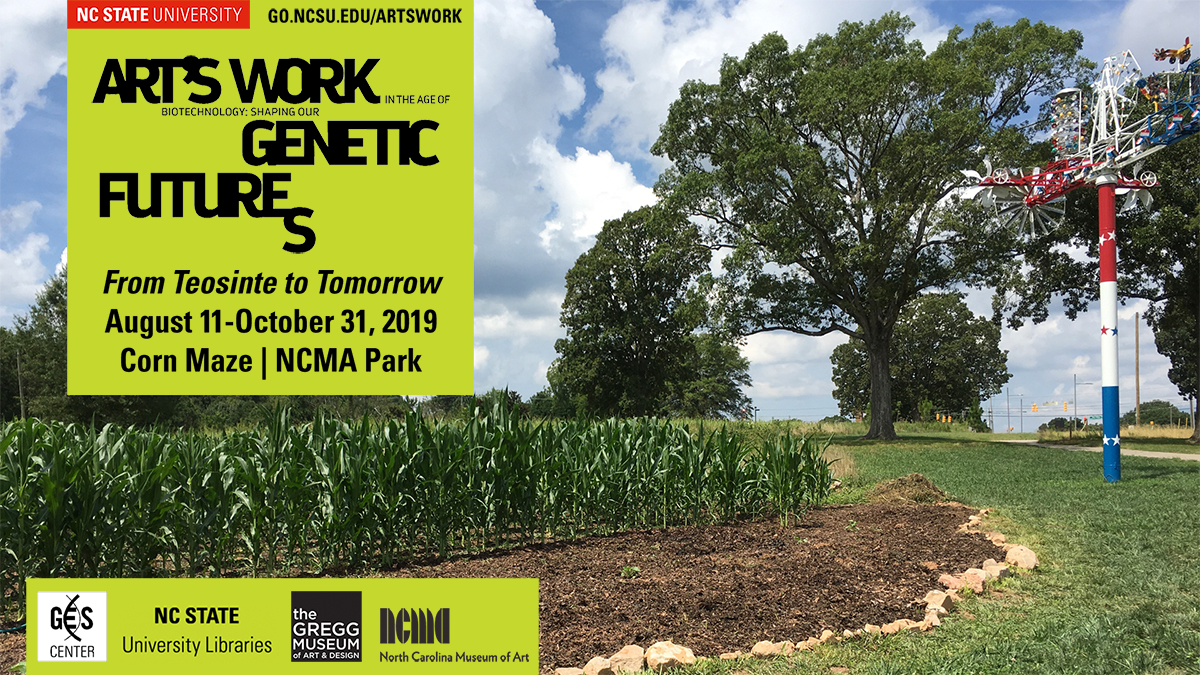 This corn maze is a time machine.
This corn maze is a time machine.
At the heart of From Teosinte to Tomorrow, a quarter-acre stand of non-GMO tropical field corn, you will find an interior room with a raised bed of teosinte, the wild grass thought to be an ancestor of modern corn.
Once there, you will have traveled thousands of years into civilization’s agricultural past, through generations of cultivation practices developed by farmers across the American continents as well as by contemporary biotechnologists. Through countless harvests, the skinny, hard kernels of teosinte grass were gradually hybridized into today’s juicy and sweet corn on the cob.
As humanity struggles with challenges like global population growth and climate change, there is a growing disconnect between first-world populations, the sources of our food, and the people who labor to grow it and deliver it. As one of the earliest cultivated grains in the western hemisphere, the cultural significance of maize (Zea mays) invites conversations about these issues as well as about issues of class, identity, community, and genetics in society.
From Teosinte to Tomorrow was inspired by artist Josef Albers and based on his photographs and drawings during the years he and Anni Albers traveled extensively in Mexico (1930s–60s). The Albers’ deep connection to Mesoamerican art, together with their importance to the growth of art and design in North Carolina, made these reflective works an apt inspirational source for NC State University Libraries exhibit designer Molly Renda and design collaborator William Dodge.
This exhibit is part of the Art’s Work/Genetic Futures art-science exhibition organized by the NC State University Libraries and the GES Center, and shown at the Gregg Museum of Art & Design, in the physical and digital display spaces of the Libraries, and here at the North Carolina Museum of Art Ann and Jim Goodnight Museum Park.
From Teosinte to Tomorrow is funded by the NC State University Libraries’ Goodnight Educational Foundation Endowment for Special Collections with additional support from the Genetic Engineering and Society Center, and in-kind donations from the College of Agriculture and Life Sciences, the JC Raulston Arboretum, Hanbury, and the North Carolina Museum of Art.
PROJECT TEAM
About the curator: Hannah Star Rogers is a curator, scholar, and poet. She received her MFA in poetry from Columbia University and Ph.D. at Cornell University on the intersection of art and science. She curated Making Science Visible: The Photography of Berenice Abbott, which received an exhibits prize from the British Society for the History of Science and resulted in an invited lecture at the Smithsonian Archives of American Art. She is past Director of Research and Collaboration for Emerge: Artists and Scientists Redesign the Future 2016 and served as Guest Bioart Curator for 2017.
Spaces & Technology: The multi-site exhibition will be held simultaneously at NC State University’s Gregg Museum of Art & Design and in the physical and digital display spaces of NC State University Libraries D. H. Hill Exhibit Gallery and the James B. Hunt Jr. Library. The earthwork, From Teosinte to Tomorrow, a 100 x 100-foot corn maze, will be planted at the North Carolina Museum of Art’s museum park.
Our project team consists of interdisciplinary scholars and artists from inside and outside NC State, including Molly Renda, Fred Gould, Todd Kuiken, Elizabeth Pitts, and Patti Mulligan.
Artists include: Joe Davis, Jon Davis, Heather Dewey-Hagborn, Richard Pell, Kirsten Stolle, Paul Vanouse, Adam Zaretsky, Emilia Tikka, Emeka Ikebude, Jennifer Willet, Charlotte Jarvis, Maria McKinney, Kerasynth, Ciara Redmond, Aaron Ellison, David Buckley Borden, and Joel Ong.
2017 FIELD TRIAL
In April 2017, Art’s Work held a pop-up exhibit that drew over 1,000 visitors to CAM Raleigh.
[wonderplugin_slider id=1]
PARTNERS
Art’s Work/Genetic Futures is a collaboration between the NC STATE UNIVERSITY LIBRARIES and the GENETIC ENGINEERING AND SOCIETY CENTER, with the GREGG MUSEUM OF ART & DESIGN and the NORTH CAROLINA MUSEUM OF ART.
We are actively seeking funding for this project. For more information contact molly_renda@ncsu.edu
